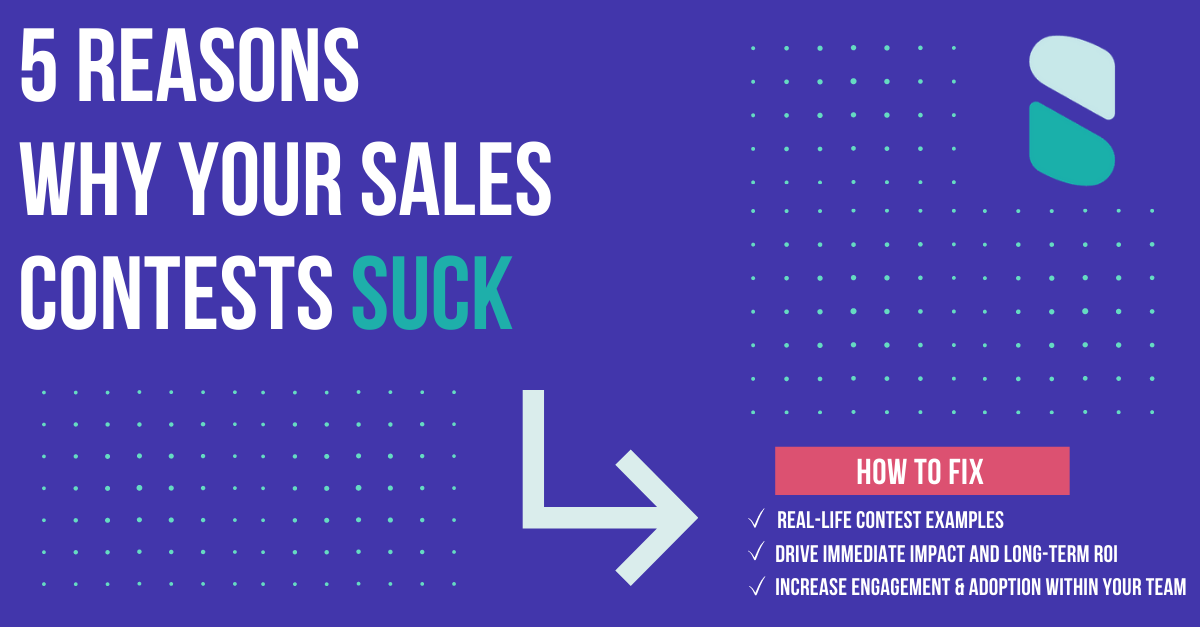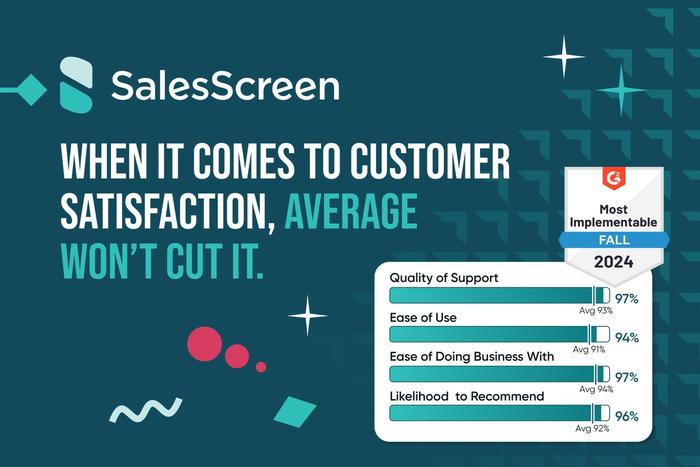We know what it’s like to roll your eyes at a dull, uninspiring and half-assed sales competition. We recently held a webinar to educate revenue teams on the best ways to make sure your sales contests don’t suck.
My colleague Matt Payne, along with Christina Brady, President of Sales Assembly and Scott Barker, Head of Partnerships at Sales Hacker did an excellent job breaking down the key reasons that most competition strategies result in diminishing returns.
You can view the full webinar embedded here:
This conversation got me thinking on the topic more and my own experience and the experience of top sellers I have the please of talking to every day. Here is a brief summary of the five issues contributing to your sales contest engagement woes:
1. Visibility: Make it visual, everyone needs to know how they’re tracking against their peers.
To make competitions work, your employees need to be aware of it and be able to track it. Sales leaders worldwide struggle with this every time they compete:
- Create the competition then broadcasts it through Slack, email, various sales meetings
- Reps are told to follow the daily updates and login to Dropbox to check the customized spreadsheet
- Manager responsible for the competition spends 1-2 hours per day updating these channels and the competition data
- Everyone dozes off because they’re spending too much energy simply searching for the information
- Manager gets tired of updating because the reps aren’t as engaged—swaps from daily updates to weekly updates
- Reps care even less, 80 percent of the reps see that they can’t win because they’re way behind
- The competition fails
- Manager doesn’t see value in sales competitions, the reps think it’s a waste - you’ve lost a very important part of your sales culture.
- Managers give away prizes they don’t want to give away because they feel that the reps haven’t deserved it
Instead, automate as much as possible. Increase notification/update frequency. Show position changes on the Leaderboard(so reps can act on it). Highlight activity improvements compared to baseline data.
2. Format: Make it possible for ANYONE to win.
In almost every sales organization worldwide, these competitions can only be won by their top 20% performers. There are always 2-3 reps that win every sales competition, there’s always that hunter that books more meetings than anyone else, there’s that enterprise rep that closes the largest deals and there’s always that SDR that calls more than anyone in the team.
Most sales competitions are designed to incentivize your top performer(s) only. As sales leaders, we HAVE to change this. Here are two examples of competition styles that bring a chance of luck into the mix, make every rep feel like “I just might win this one”:
1. Wheel of Fortune / Lottery
Let’s say you want to book more meetings: Every time anyone of your reps book a meeting, they get a ticket - the more meetings you book, the more tickets you get. At the end of the period, the manager spins the wheel. More tickets = higher probability of winning, one ticket = You can win
2. Multiple Targets, Multiple Prize Blitz
Most competitions come from a place of need: “We need $100,000 more revenue this Q to reach our target.” Well, create a competition that lets your team see how they’re progressing towards these targets. The multiple targets design lets you create multiple-part goals:
- 1st goal: $50K - Half-Way There: Breakfast on the house for the team
- 2nd goal: $80K - So Close: Bottle of wine for every team-member
- 3rd goal $100K - We Made It: Team dinner
- 4th goal $120K - Success: Team dinner AND drinks
- 5th goal $150K - Dominating: Dinner, drinks, hotel-weekend
3. Prizes: Make the prizes interesting, rewarding, and personal!
We see this failing over and over again. Leaders create prizes for competitions based on their own preferences “I love craft beer, so the winners of this competition get a box full of weird craft beer if we win” It doesn’t work.
Make it relevant, make it personal. Think about sports. Golf, Formula 1, Poker, Boxing. All these sports have one thing in common, they hand out points/prizes/reward money to 50 percent or more of the participants.
Let’s use Formula 1 as an example:
- 20 drivers globally
- 10 teams with two drivers each
- 4 potential winners because of the way the car is designed it’s only Mercedes and Red Bull that can win at the moment
- 20 drivers sacrificing their life every other weekend
Why? Because they reward them in the following way
- 1st place: 25 points
- 2nd place: 18 points
- 3rd place: 15 points
- 4th place: 12 points
- 5th place: 10 points
- 6th place: 8 points
- 7th place: 6 points
- 8th place: 4 points
- 9th place: 2 points
- 10th place: 1 point
With this the 11th best rep/driver wants to give it their all to get into the points/money, the 7th best rep/driver is going to do what they can to get into 6th or 5th. The game isn’t about winning, it’s about doing whatever you can to get as high up in the money as possible. This approach generates revenue for sales teams.
Some companies leverage a digital coin-system that lets you teardrop prize winnings like Formula 1 and connect the coins with a reward shop. This gives the reps the possibility to accumulate coins in competitions and gives them the possibility to win things they need. That could be craft beer, but it could also be a gift card to the local restaurant or a new stroller for that rep’s newborn.
4. Repetition: Change it up, be innovative, and ask your team how do they want to compete?
Repetition is a part of your rep's everyday life, if it’s cold calling, pitching, negotiation, or closing - they repeat themselves day in/day out. Running back-to-back cold calling competitions just doesn’t work. Change it up, but again, that’s difficult when you have an excel-spreadsheet and your own imagination to work with.
We’ve analyzed over 20,000 competitions completed in SalesScreen in 2020, and the data is staggering:
- If you start competitions on a Tuesday vs a Monday - you’ll see on average a 24.7% increase in performance
- Compete on early-stage metrics(calls, pipeline, meetings) and see on average +70% increase
- Create 1-day blitzes and see a 53.2% average increase
- Competing remotely vs in the office sees a 7.2% increase in performance
5. Metrics: Make sure the metrics are relevant and that the timeframe is feasible.
Looking to create contests that drive immediate impact AND long-term ROI? Start by taking a close look at your top metrics:
- Early-stage KPIs (calls, e-mails, LI activity, discovery and first-time meetings, new opportunities, follow up meetings) = Short competition period (0-5 days)
- Late-stage metrics (pipeline movement, proposals/ offers, closed-won deals) = Longer competition period (5-30 days)
We can’t expect our reps to be overproductive for more than a couple of days at a time, that’s what our data tells us. When organizations compete on calls, meetings for a 30 day period, you’ll see two spikes in your chart, at the start, and at the end.
Make that two separate competitions instead! If your sales cycle is 60 days, it doesn’t make sense to create a two-day competition on closing deals either - make sure the way you compete is backed by YOUR data. We’ve created a pretty simple formula for competition success.
Follow these and we guarantee increased performance, productivity, and employee engagement:
- Gap analysis
- Define KPIs/Metrics
- Choose competition length
- Create rules
- Define prizes
- Kick-off
- Half time talk
- Celebrate
TLDR;
In summary, here are the 5 reasons your competitions suck and how to fix them:
1. Poor Visibility
Reps can’t compete if they can’t easily see what’s happening ---> Make it visual, everyone needs to know how they’re tracking against their peers - preferably in real-time.
2. Traditional Format
Most sales competition formats only motivate the top performers(top 20%) ---> Make it possible for ANYONE to win.
3. Non-Personal Prizes
Not everyone cares about the same thing ---> Make the prizes interesting, rewarding, and personal!
4. Repetition Fatigue
Doing the same competitions over and over(and expecting different/better results) is the definition of insanity ---> Change it up, be innovative - ask your team - how do they want to compete?
5. Misaligned Metrics and Time-Frame
Competing on end-of funnel metrics vs early-stage metrics requires different formats and different durations ---> Make sure the metrics are relevant and that the time frame is possible.










